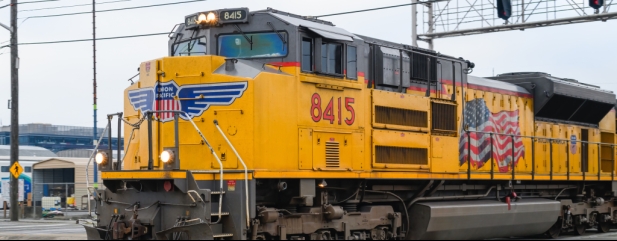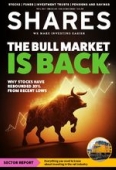Archived article
Please note that tax, investment, pension and ISA rules can change and the information and any views contained in this article may now be inaccurate.
All aboard! How to invest in the rail sector and the stocks to watch

There are several reasons to invest in the rail sector. For one, there is continued investment by governments from the UK, US and Europe in rail infrastructure and technology.
The railway industry is starting to take notice of its own carbon emissions and is taking steps to cut its carbon footprint. For example, UK railway company Network Rail has a 30-year strategy to deliver a more sustainable network across the whole of Britain.
In Europe, France has recently banned domestic short-haul flights where train alternatives exist, in the country’s attempt to cut back emissions by 50% by 2030.
Another reason to invest in the rail sector is because of legendary US investor Warren Buffett. If it is good enough for Buffett, there is a widely held view that it must be good enough for the average investor.
Buffett’s investment firm Berkshire Hathaway (NYSE:BRK.B) owns rail company BNSF (Burlington Northern Santa Fe). Buffett believes his investment in US rail demonstrates his faith in the strength of the US economy.
Investors can put money into shares of companies involved in freight or passenger rail services – with freight names having typically delivered stronger returns in the past. There are also companies on the stock market which provide products and services to the industry.
FREIGHT RAIL
During the period 1 April to 31 March 2022 total freight moved by rail in the UK increased by 11.3% to 16.87 billion net tonne kilometres, 1.8% higher than April 2019 to March 2020, according to the Office of Rail and Road. This data shows that the amount of freight moved across the UK’s railways has returned to pre-pandemic levels.
The reason for this increase in freight rail usage is not just because of environmental reasons. According to the International Energy Agency rail is among the most energy efficient modes of transport for freight and passengers. While the rail sector carries 8% of the world’s passengers and 7% of global freight transport, it represents only 2% of total transport energy demand.
US rail freight operator Union Pacific (NYSE:UNP) reports one locomotive can move one tonne of freight more than 400 miles on a single gallon of diesel fuel. This generates a carbon footprint 75% smaller than trucks classified as heavy goods vehicles over the same distance, says the IEA.
FROM GLOBAL TO LOCAL LEVEL
Another reason why rail freight usage has grown is because of ‘complicated geopolitical circumstances following the pandemic,’ says Stephen Yiu, fund manager at the Blue Whale Growth Fund (BD6PG78), so ‘more goods will be produced in the West.’
Yiu says: ‘Beneficiaries (of this theme which is called reshoring) are those companies which facilitate renewed industry and those that are already producing key items in benign territories.’
Reshoring (also known as onshoring) is the process of returning the production and manufacturing of goods back to the company’s original country. It is the opposite of offshoring, which is the process of making goods overseas to try to reduce the cost of labour and manufacturing.
To play this reshoring theme, Blue Whale has invested in two rail companies in North America – Union Pacific and Canadian National Railway (NYSE:CNI). ‘With a comprehensive rail network between the two, they provide key infrastructure for North America to drive this era of reshoring.’
SHIPPING WOES
Rail freight usage has also benefited from the ‘fallout’ from shipping. The pandemic showed shipping goods in deep sea containers in a bad light – often the goods got stuck due to Covid restrictions, for example in China, causing suppliers to lose money and consumers not to get their goods. Rising inflation and the inability to get staff at the seaports also pointed to the unreliability of shipping goods by sea compared to rail.
An extreme example of when shipping goods went wrong occurred in March 2021, when one of the world’s biggest container ships called the Ever Given got stuck in the Suez Canal for almost a week. By being stuck the Ever Given managed to hold up an estimated $9.6 billion of goods each day, according to Lloyd’s List.
INVESTING IN OVERSEAS-LISTED RAIL SHARES
There are a number of US-listed rail companies that have delivered double-digit average annual returns over the past decade.
Union Pacific has delivered 11.6% annualised returns over the past 10 years. It connects the western two-thirds of the US by rail – from the West Coast and Gulf Coast ports to eastern gateways, Canada’s rail systems and Mexico gateways. Last July, Union Pacific signed a $1 billion deal with Wabtec (WAB:NYSE) to modernise around 600 trains.
Canadian National Railway operates from the Atlantic Coast in Nova Scotia to the Pacific Coast in British Columbia. It has a market capitalisation of C$90 billion and its biggest shareholder is the Bill & Melinda Gates Foundation at 8.1%. Over a 10-year period it has delivered a 13.4% annualised total return.
CSX (CSX:NASDAQ) is a US rail company which has customers in various markets including energy, construction and agriculture. Over a 10-year period CSX has delivered a 16% annualised return, according to Morningstar.
French rail transport company Alstom (ALO:EPA) makes rolling stock and has built, or is building, just under 40% of the UK mainline train fleet. It has been a more volatile investment, with its share price doubling between 2016 and 2020, however it has since lost most of those gains.
The company recently said it was testing its first regional hybrid train on the Toulouse / Mazamet and Toulouse / Rodez lines. Christophe Fanichet, chairman and CEO of SNCF Voyageurs said: ‘The skills of the SNCF and Alstom technical teams have made it possible to meet the challenge of integrating an innovative traction system into an existing rolling stock, thus paving the way for the decarbonisation of regional trains.
‘With the first hybrid regional train, Occitanie is the only region involved in all the trials of innovative rolling stock to reduce CO2 emissions, efficiently and quickly.’
INVESTING IN UK-LISTED RAIL SHARES
With Go-Ahead having delisted from the London Stock Exchange last October following a takeover, FirstGroup (FGP) is the only primary passenger rail company left on the UK stock market.
It is the UK’s largest rail operator, covering long-distance, commuter, regional and sleeper services under such franchises as GWR, Avanti West Coast and Hull Trains. It also operates a variety of bus services.
FirstGroup’s share price has increased by a third year-to-date as the company continues its post-pandemic recovery, although it did lose the TransPennine rail contract in May after the government took control of the franchise following a period of significant disruption to travellers.
Elsewhere, there are various rail-related companies on the stock market providing services to the industry.
Shares in ticketing platform Trainline (TRN) have been volatile since listing in 2019, hitting highs of 545p and lows of 164p. Admittedly the pandemic in 2020 derailed the business but it has struggled to win back the market’s favour despite ambitions to be a bigger player across Europe.
Trainline reported a 72% rise in net ticket sales of £4.83 billion for the year ending 28 February 2023. Russell Pointon from research group Edison, said: ‘Trainline expects further ticket sales and revenue growth of 13-22% in its FY24 outlook, and with its considerable expansion potential into new and existing European markets, it looks like the ticketing provider may just steam ahead to even higher profit growth given management’s guidance on profit margin.’
Tracsis (AIM:TRCS) is a company specialising in software to help railway operators manage their operations, such as rail crew scheduling and resource management. It has expanded its operations to include ticketing, data analytics and geographic information systems. Over the past five years Tracsis’ shares are up 68% to 933p.
Analysts at Stifel say Tracsis has ‘a track record of growth, profitability and successful acquisitions’ and it targets an average of 10% organic growth per year, which can be accelerated though acquisitions.
Stifel adds: ‘Since 2010, Tracsis has delivered compound annual growth rate of 33% for revenue. The company raised £7 million at admission to AIM in 2008 and an additional £2 million in 2011. Since then, it has made 17 acquisitions while continuing to invest in product development and paying dividends.’
Important information:
These articles are provided by Shares magazine which is published by AJ Bell Media, a part of AJ Bell. Shares is not written by AJ Bell.
Shares is provided for your general information and use and is not a personal recommendation to invest. It is not intended to be relied upon by you in making or not making any investment decisions. The investments referred to in these articles will not be suitable for all investors. If in doubt please seek appropriate independent financial advice.
Investors acting on the information in these articles do so at their own risk and AJ Bell Media and its staff do not accept liability for losses suffered by investors as a result of their investment decisions.
Issue contents
Feature
Great Ideas
News
- Why Vodafone’s marriage of convenience with Three leaves questions hanging
- Cost of UK mortgages breaches 6% while June house prices fall for the first time in five years
- Shares in this US restaurant business more than doubled on its stock market debut
- Motorpoint shares slump as profit wiped out amid a multitude of factors
- Unfavourable exchange rates leave many Japan fund investors lagging Japanese stock rally

 magazine
magazine








